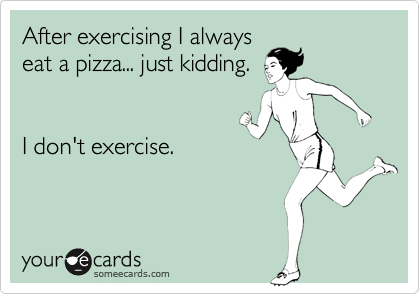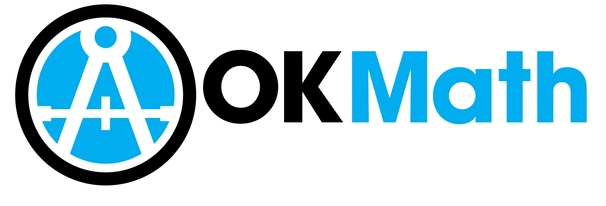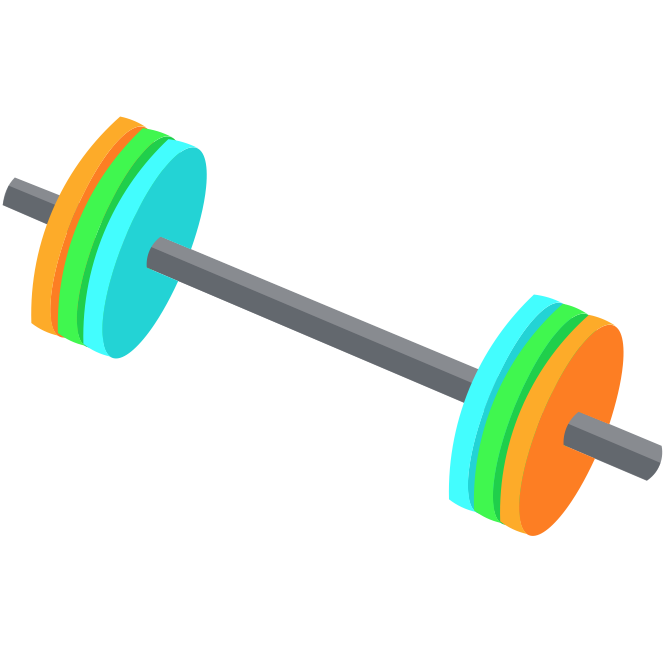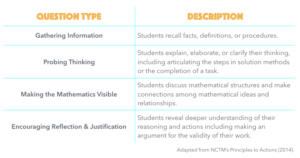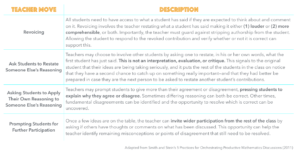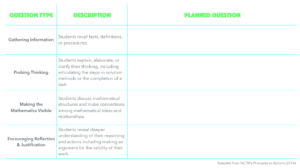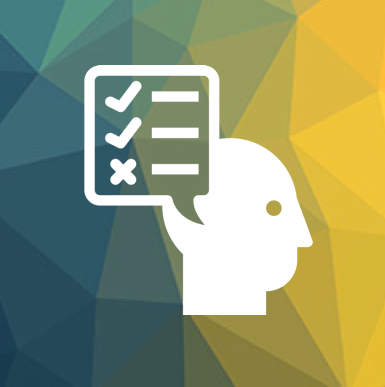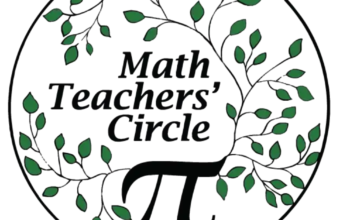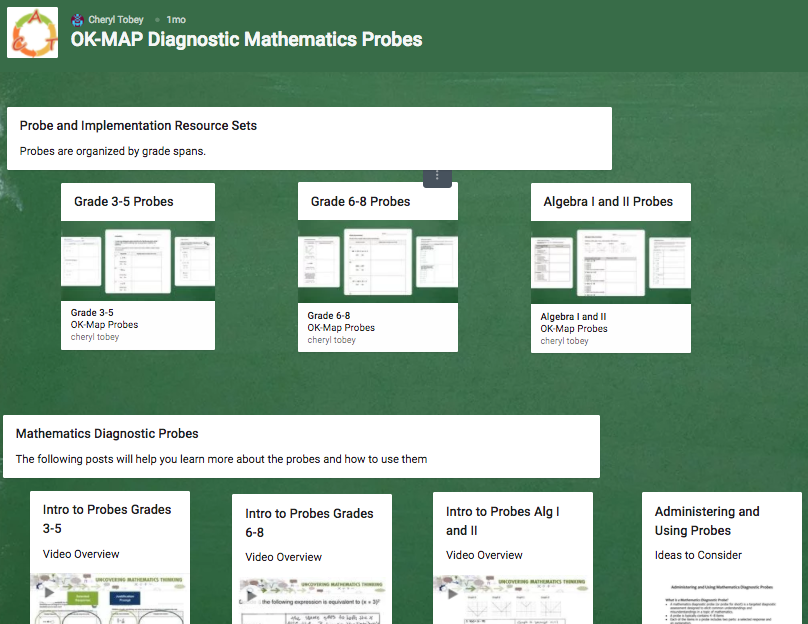Welcome to Week #2 of the first cycle of the Math Task Force! We are glad you’ve joined us! This week, we’re going to continue to push you to strengthen your teaching practice! Before you get started, we’ve got a follow-up poll for you from last week’s workout.
[This warm up only lasts about 15 minutes. If you have the endurance for it, you can also do the Heavy Lift set that should last about 20-30 minutes.]
Part 1) Stretch It Out
The questions teachers ask during their instruction is incredibly important. The best learning experiences hinge on engaged learners who see themselves as active participants. Active learning doesn’t happen by accident though. In this workout, we’re going to look at the essential components of the classroom discussion and start thinking a little about what we can do to make sure those conversations are happening in our classroom.
In their remarkably good book, “5 Practices for Orchestrating Productive Mathematics Discussions,” Peg Smith and Mary Kay Stein argue that almost every good classroom discussion begins the same way: with a good task and an invitation for students to “share how [they] solved a particular problem.” Sounds simple right? While we’ll get to the first part (finding a good task) later, we really want to focus on what kinds of questions can be used right after the teacher has made this invitation to their students. What does it really mean to launch a meaningful conversation and what does the teacher need to be ready for?
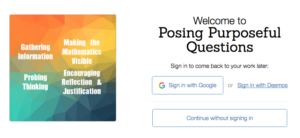 To kick off, we’ve got a nice stretch for you. Go to our card sort at Desmos and see if you can match the descriptions and example questions to the correct question type. We’re supposing you still remember last week’s 9 question types from Broadie and Boaler… these four types that we’re introducing now are another framework that we’re going to use to help focus us on the question types we really want to understand deeply. Once you finish the Card Sort, come on back here.
To kick off, we’ve got a nice stretch for you. Go to our card sort at Desmos and see if you can match the descriptions and example questions to the correct question type. We’re supposing you still remember last week’s 9 question types from Broadie and Boaler… these four types that we’re introducing now are another framework that we’re going to use to help focus us on the question types we really want to understand deeply. Once you finish the Card Sort, come on back here.
[scbutton link=”http://student.desmos.com?prepopulateCode=udqh” target=”blank” variation=”green” size=”medium” align=”center”]Complete Card Sort Here[/scbutton]
HEY NOW! DON’T READ AHEAD UNTIL YOU DO THE CARD SORT.
How’d you do? Just in case you didn’t do the activity, you can look at the four types, descriptions, and examples here. No peeking!
Part 2) Cardio
Let’s start breaking this down a little more. In this next section we’re going to look into what the lesson actually looks like. To kick off, take a look at the storyline below. (click image to enlarge)
Q1) What do you Notice?
Q2) What do you Wonder?
Thinking about the structure of a problem-focused learning experience, the teacher has a huge responsibility to ensure their questions don’t get stuck in the information gathering style. That type of questioning doesn’t support creating a shared understanding of the key mathematics within the task. Similarly, questions that go straight to the mathematics can cause some students to shut down. To help us think about piecing this together, we are going to explore the green part a little. What does it look like to ask Focusing Questions while also encouraging multiple student responses that build toward shared understanding?
Let’s start back at the four question types we looked at during the stretch. Read the descriptions and think about when in the storyline do these questions show up. (click image to enlarge)
Q3) Which of these question styles do you feel most comfortable with?
Q4) Which of these question styles do you want to get better at and why?
A common questioning style, Initiate-Response-Evaluate (I-R-E) usually uses one specific question type from the table below. In the I-R-E questioning pattern, “the teacher starts by asking a question to gather information, generally with a specific response in mind; a student responds, and then the teacher evaluates the response. It is not uncommon for teachers to allocate less than five seconds for a student to respond, and to take even less time to consider the answer for themselves” (Mehan 1979, quoted in NCTM 2014).
With this in mind, there are five teacher moves we can practice this week to really make sure we aren’t falling into the I-R-E pattern rut. First, take time to appreciate the types of questions shown here. How do they relate to each other? When can you use them in your classroom?
Second, let’s think about what will happen once you pose your Focusing Question. Again, Smith and Stein have something to say on this matter and share moves effective teachers use to “position students advantageously both in relation to one another and in relation to the mathematics.” (click image to enlarge)
Q5) When can you visualize yourself using these moves in your classroom? Jot down these 4 moves onto a couple of post-it notes and then put them in strategic places around your classroom (like at your podium or in your teacher’s edition book). Use these notes to jog your memory of the effective teacher moves that you should be using to encouraging multiple student responses that build toward shared understanding.
Part 3) Heavy Lift
Many times during lesson planning, the focus is on the answer the students will give rather than the questions being asked. This type of planning ignores the most basic learning model of life in which our minds are set up to not care about answers unless we have a question. The greater the question, the more compelling it is, the more we want the answer. We learn best when questions come before answers. Knowing this, lesson planning needs a makeover to focus more on the questions we pose to get the desired answers.
To help us explore the questions you ask and the moves needed to promote rich discussions in your classroom, let’s think about a few questions and follow-up moves you can use in your next lesson or task. Below is a planning page you could use to sketch out a first draft of your questions for an upcoming math lesson or task. Do you see a flow within your questions that is encouraging multiple student responses that build toward a shared understanding of your objective? As all good writers do, revise your thinking and edit your questions to help create the true storyline of learning you want visible in your classroom. Use the following questions to guide you as you complete the planning page: (click image to enlarge)
22 kBQuestion Planning DocQ6) For an upcoming lesson/task, what is a Probing Thinking question you could use? Based on an expected response from students to your question, what Teacher Move might you deploy next and why?
Q7) For the same lesson/task, what is a Making the Mathematics Visible question you might use? Based on an expected response from students to your question, what Teacher Move might you deploy next and why?
Q8) For the same lesson/task, what is an Encouraging Reflection and Justification question you might use? Based on an expected response from students to your question, what Teacher Move might you deploy next and why?
Let us know what you think here. Stayed tuned for another warm-up activity next week!
